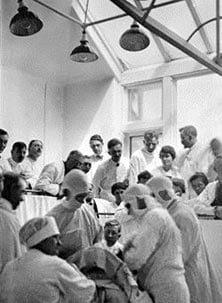Department and Surgery History

In the mid-1800s, two brothers, Dr. William J. Mayo and Dr. Charles H. Mayo, joined their father's medical practice in Rochester, Minnesota. By the late 1800s, their practice had flourished, and Drs. Will and Charlie Mayo together were operating on nearly 4,000 patients a year and became surgical experts.
Additional surgeons were hired to help with the workload, and soon their practice became known as Mayo Clinic. Recent medical school graduates began to apply to intern with Drs. Will and Charlie Mayo. The first surgical resident was Dr. Melvin Millet, who began working for the Mayo brothers in 1889.
Formal surgical training began in 1915 when Drs. Will and Charlie Mayo provided funds to establish Mayo Foundation as a postgraduate educational institution within the framework of the Graduate School of the University of Minnesota, becoming the first three-year university-based program to train graduate physicians in specialty practice.
Physicians accepted for training were registered as students in the Graduate School and were granted a Master of Science degree or a Doctor of Philosophy degree. In 1983, Mayo Graduate School became independent and was no longer affiliated with the University of Minnesota.
Mayo surgeons have made many contributions to the practice of surgery. Dr. Will Mayo is associated with sighting the prepyloric vein. The first-ever successful total pancreatectomy was performed by Mayo surgeon Dr. James Priestley. The Sistrunk procedure for thyroglossal duct cysts was developed by Dr. Walter E. Sistrunk. Dr. Alfred Adson and Dr. John de J. Pemberton developed tests for detecting thoracic outlet syndrome.
Mayo surgeons have developed surgical equipment such as Mayo scissors, Mayo forceps, Mayo surgical stands, Mayo retractors, Rankin surgical clamps, Masson fascia stripper, Balfour operating table, Balfour self-retaining retractor, Harrington retractor, Harrington bayonet forceps, Mayo-Gibbon heart-lung machine, Mayo sterile surgical camera, and monitoring equipment for use in the operating room and in the postoperative recovery room.
Mayo surgical alumni have served as presidents of the:
- American Medical Association — Drs. William Mayo, Charles Mayo and E. Starr Judd
- American College of Surgeons — Drs. William Mayo, Charles Mayo, Donald Balfour, Fred Rankin, William Estes, Harold Foss, Walter MacKenzie, Howard Mahorner, James Priestley and Oliver Beahrs
Mayo-trained surgeons who became academic leaders at other institutions include:
- Dr. Stewart Welch, University of Albany
- Dr. Ralph Deterling, Tufts University
- Dr. Robert Coffey, Georgetown University
- Dr. Alexander Walt, Wayne State University
- Dr. Robert Frater, Einstein University
- Dr. Rene Menguy, University of Chicago
- Dr. John W. Kirklin, University of Alabama
Past and current Department of Surgery chairs include:
- Dr. John W. Kirklin
- Dr. George A. Hallenbeck
- Dr. Robert B. Wallace
- Dr. Donald C. McIlrath
- Dr. Keith A. Kelly
- Dr. Peter C. Pairolero
- Dr. Claude Deschamps
- Dr. Heidi Nelson
- Dr. Michael L. Kendrick
Past and current General Surgery Residency program directors include:
- Dr. Donald C. McIlrath
- Dr. Peter Mucha Jr.
- Dr. David M. Nagorney
- Dr. David R. Farley
- Dr. Stephanie F. Heller
- Dr. John M. Stulak
- Dr. Mariela Rivera
Today, Mayo surgeons and trainees continue to carry on the traditions of their founding forefathers as they care for their patients' needs, strive for advances in surgery, and promote teamwork and efficiency in their practice.